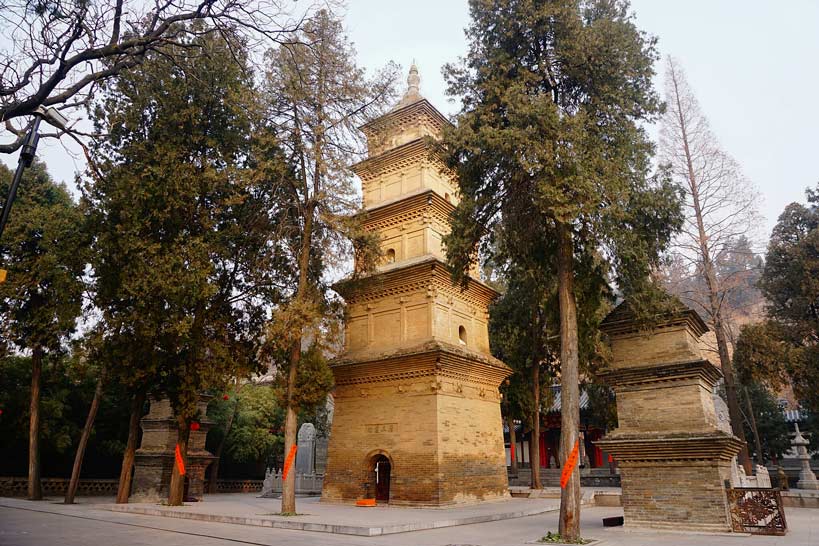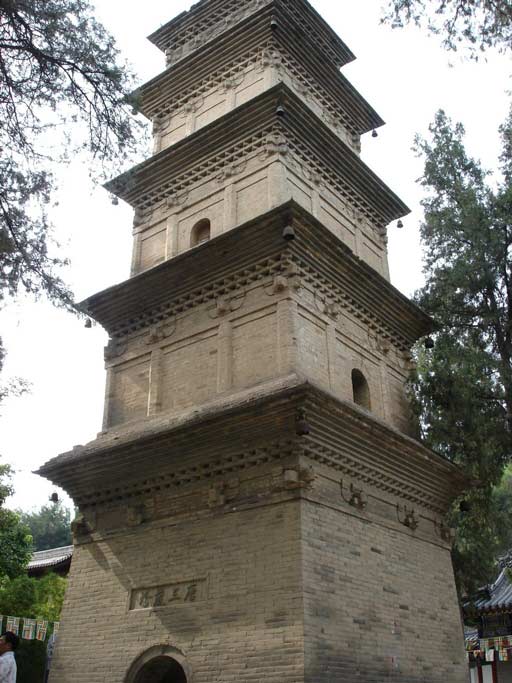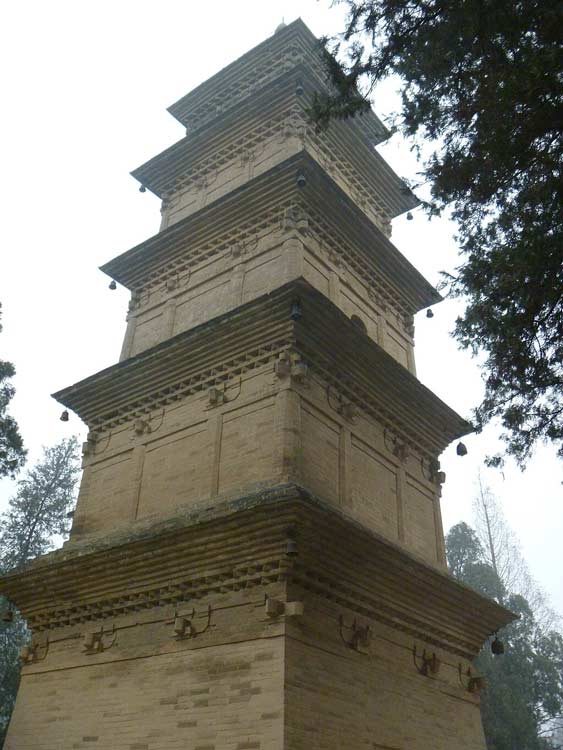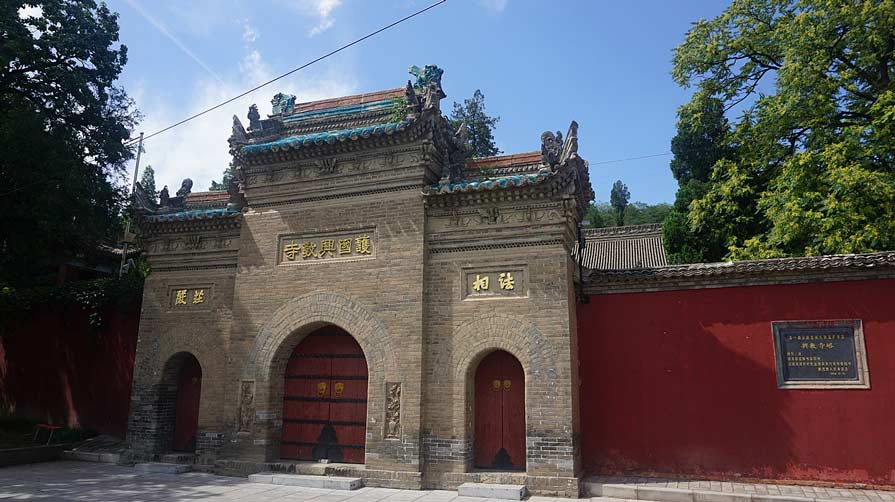


In this article, we will explore the fascinating history of the Xingjiao Temple Pagoda! This amazing monument sits right at the heart of the Chang’an District in Xi’an, of the Shaanxi Province, China. As a designated UNESCO World Heritage Site, the Xingjiao Temple Pagoda holds within its wall’s stories of ancient splendor and profound cultural significance that are bound to pique your interest.
Cover Image – Xingjiao Temple Pagoda housing the remains of the monk Xuanzang and the 2 smaller pagodas on the left and right hold the remains of his disciples, monk Kuiji and monk Yuance.
The Xingjiao Temple Pagoda is located on the Shaoling Plateau, within the Chang’an District of Xi’an, Shaanxi Province, China. The plateau is a UNESCO World Heritage Site and is known for its historical and cultural significance. The Xingjiao Temple Pagoda is one of the most popular attractions on the plateau.
The Xingjiao Temple Pagoda was built in 669 AD, during the Tang Dynasty. The Tang Dynasty was a golden age for China, and it was a time of great cultural and economic exchange. The Xingjiao Temple Pagoda was built to commemorate this period of prosperity and to honor Xuanzang, who had played a major role in promoting cross-cultural exchange.
The Xingjiao Temple Pagoda was built to house the body of the monk Xuanzang. Xuanzang was a Buddhist monk who traveled to India in the 7th century AD. He spent 17 years in India, studying Buddhist scriptures and collecting texts.
When he returned to China, he brought back with him over 600 Buddhist texts. Xuanzang’s journey was a major undertaking, and it helped to spread Buddhism throughout China. The Xingjiao Temple Pagoda was built to commemorate Xuanzang’s achievements and to serve as a final resting place for his body as well as to store some of the scriptures that he had brought back from India.
The Xingjiao Temple Pagoda is 21 meters tall. It is made of brick and has five stories. Some historians have theorized that the five stories of the pagoda represent the five elements of Chinese philosophy: wood, fire, earth, metal, and water. The pagoda is also topped with a conical roof, which is a common feature of Chinese pagodas at the time.
The Xingjiao Temple Pagoda was named by Emperor Suzong of the Tang Dynasty. The name “Xingjiao” means “Flourishing Teaching.” This name was chosen to reflect the importance of the pagoda as a center for Buddhist learning.
The Xingjiao Temple Pagoda is a blend of Chinese and Indian architectural styles. The pagoda has a wood-like brick structure, which is inspired by Indian pagodas. The five stories of the pagoda are topped with conical roofs, which are also a common feature of Indian pagodas. The roofs of the pagoda are decorated with intricate carvings of Buddhist symbols, such as the lotus flower and the wheel of Dharma.


Xuanzang’s journey to India had a major influence on the design of the Xingjiao Temple Pagoda. The pagoda’s wood-like brick structure is inspired by the wooden pagodas that Xuanzang would have seen in India. The intricate carvings on the roofs of the pagoda are also inspired by Buddhist art that Xuanzang would have encountered on his travels.
The Xingjiao Temple Pagoda houses a number of cultural artifacts, including the remains of Xuanzang. The pagoda also houses a collection of Buddhist scriptures, as well as other artifacts that were brought back from Xuanzang’s travels to India.
The remains of Xuanzang are housed in a golden casket on the top floor of the pagoda. The Buddhist scriptures are housed in a library on the second floor of the pagoda. The other artifacts are housed in a museum on the ground floor of the pagoda.
The Xingjiao Temple Pagoda played an important role along the Silk Road. It was a popular stop for travelers, who would come to pay their respects to Xuanzang and to learn about Buddhism. The pagoda was also a place where scholars could gather to study and discuss Buddhist texts. The Xingjiao Temple Pagoda was a symbol of the cross-cultural exchange that took place along the Silk Road. It was a place where people from different cultures could come together to learn about each other’s religions and philosophies.
Xuanzang’s translations of Buddhist texts had a major impact on Chinese culture. His translations introduced new ideas and concepts to China, and they helped to shape the development of Chinese Buddhism. Xuanzang’s work also had a significant impact on Chinese literature, as it inspired many works of fiction and poetry.
The Xingjiao Temple Pagoda is a reminder of the importance of cross-cultural exchange. It is a symbol of the connections that were forged along the Silk Road, and it continues to inspire people from all over the world. The pagoda is a testament to the power of knowledge and understanding, and it is a reminder that we can all learn from each other, regardless of our cultural differences.
The Xingjiao Temple Pagoda is a fascinating and important monument. It is a testament to the power of knowledge and understanding, and it continues to inspire people from all over the world. If you are ever in Xi’an, I highly recommend visiting the Xingjiao Temple Pagoda. It is a truly awe-inspiring sight, and it is a place where you can learn about a rich and fascinating history.

Related Articles:
Xi’an FAQs: Exploring China’s Ancient Capital City!
Exploring the 6 UNESCO World Heritage Sites in Xi’an!
Giant Wild Goose Pagoda FAQs: Exploring this iconic pagoda!
The Small Wild Goose Pagoda: Answering 7 FAQs!
What is a Pagoda? Exploring these Iconic Asian Towers!
China’s UNESCO World Heritage Sites: A Complete A-Z List!
UNESCO World Heritage Sites: The Ultimate Guide!